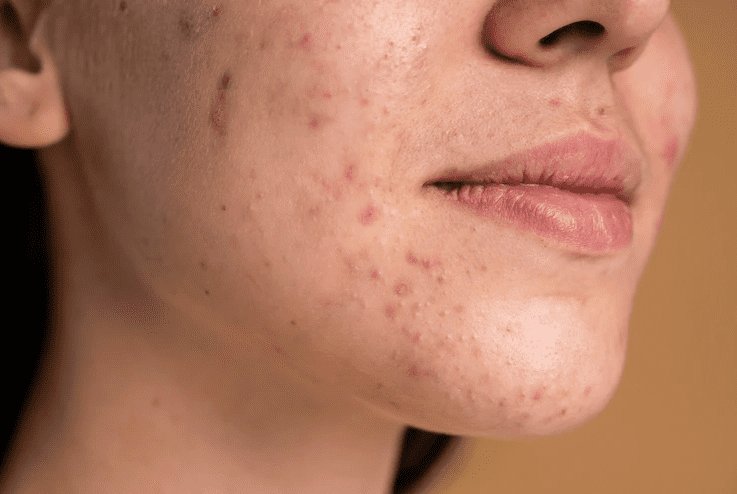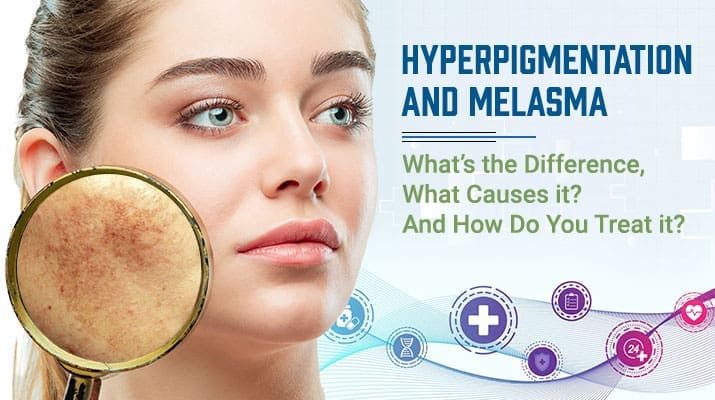Introduction to Hyperpigmentation and Melasma
If you suffer from dark spots and marks on your skin, you’re not alone! Hyperpigmentation and melasma are very common conditions that affect millions of Americans each year. But how do you tell the two apart from one another? The two share common symptoms. Similar conditions also cause them. To break through the confusion, let’s take a deeper dive into distinguishing hyperpigmentation and melasma.
What is Hyperpigmentation?
Hyperpigmentation is a broad term often used to describe several conditions where a patch of your skin becomes darker than the surrounding tissue. This term could cover freckles, sun spots, and liver spots, to name a few. However, these conditions can be caused by a wide variety of culprits. From medications to inflammation and acne scarring, there are many reasons you might see changes to the pigment of your skin.
And one of those is decidedly caused by exposure to the sun. UV rays are incredibly harmful to unprotected skin and can cause permanent sun damage as you age. This damage often appears as sunspots, freckles, and even certain skin cancers. And whether caused by UV exposure or scarring, these conditions all fall under the umbrella of hyperpigmentation.

The Triggers of Hyperpigmentation
While triggered by many skin issues, hyperpigmentation typically occurs due to increased melanin production. This can cause certain patches of your skin to darken more than the surrounding areas, creating unsightly patches that are troublesome for many individuals. Depending on the root issue, these patches can appear as minor freckles or cover large portions of the body.
Different Forms of Hyperpigmentation
Several types of hyperpigmentation exhibit similar symptoms, including:
• Sunspots
As we’ve mentioned, exposure to UV rays can heavily contribute to the development of sunspots and freckles as we age. Additionally, this exposure can heavily increase the chances of developing various forms of skin cancer.
• Melasma
Melasma is a condition theorized to be spurred on by hormonal changes in the body. This condition is known for forming in females during pregnancy, causing increased pigmentation on any area of the body, though it traditionally begins around the hands and face.
• Post Inflammatory Hyperpigmentation
If you injure your skin or develop inflammation in your skin’s tissue, it can cause hyperpigmentation. This is a common result of acne and the scarring caused by it.
Melasma and Its Causes
We’ve briefly touched on melasma, but let’s touch on the condition in a bit more detail. Melasma is a skin issue that’s typically characterized by the presence of brown or grayish freckles and patches that form on the skin. In most circumstances, the condition is painless, harmless, and dissipates after a few months.
Melasma is often referred to as the “mask of pregnancy” due to its prevalence in pregnant women. This occurs as the result of hormonal changes that can affect the production of your skin cells. These cells overproduce, causing hyperpigmentation on the face. Though frustrating to endure, it’s often treatable with ointments and over-the-counter medications and will usually fade on its own.

Though this condition typically involves sudden hormone fluctuations, it can also be spurred on by a host of other complications, including:
• Inflammatory Conditions
Acne inflammation, pimples, and scars can all affect the coloration of your skin.
• Genetics
Some physicians believe certain genetic components cause individuals to be predisposed to developing melasma. For example, nearly 50% of people who suffer from the condition report that other family members have the disease.
• UV Radiation
Some melasma patients develop the condition due to exposure to harmful ultraviolet rays from the sun. These rays can damage your skin, cause scarring, and lead to darker skin patches and freckles.
• Phototoxic Drugs and Makeup Products
Some prescription medications, skin care creams, and even makeup products are known to make skin more sensitive to light. This sensitivity can exacerbate symptoms already caused by sun exposure.
• Medications
Some antiseizure medications and contraceptives contain ingredients that are known to cause melasma.
• Hypothyroidism
Hypothyroidism is a condition where the thyroid gland is underactive and doesn’t produce enough thyroid hormone. This can lead to issues with melasma brought on by hormone changes.
Melasma and Hyperpigmentation Treatment
Melasma is notoriously hard to diagnose and treat. If you believe that you suffer from the condition, you’ll undoubtedly want to visit your dermatologist or healthcare provider to schedule a check-up. These professionals will help you diagnose your issue and determine the root causes. And while melasma and hyperpigmentation are challenging to treat, there are several treatments and procedures that can relieve some of the symptoms.
1. Prescription Medications
Topical medications, such as azelaic acid, can be applied to the affected area to relieve symptoms caused by melasma. A number of them are available that target different causes of the condition. Some of these include:
• Hydrocortisone
Hydrocortisone can help reduce the overall appearance of melasma by fading the pigmentation. It is also known to lessen the likelihood of developing dermatitis.
• Hydroquinone
This medication is applied topically, which lightens the skin in the affected area.
• Methimazole
This is an antithyroid medication known for removing additional pigmentation left behind by Hydroquinone treatments.
2. Procedures
There are several procedures one can undergo to reduce the effects of melasma. These include:
• Resurfacing Lasers
Intense pulses of light are aimed at the affected skin to destroy the damaged, pigmented tissue layer by layer. It’s very effective at removing sunspots, freckles, and blemishes but does not treat the root causes of melasma.
• Dermaplaning
Dermaplaning is a process where a physician uses a special tool to scrape off the top layer of dead skin. It’s known to reduce wrinkles, remove unsightly peach fuzz, and reduce the appearance of dark patches caused by melasma.
• Chemical Peels
Much like dermaplaning and laser therapy, chemical peels use specially formulated acids to remove the upper layer of dead skin cells, leaving behind rejuvenated skin beneath. And much like the other procedures, chemical peels can have a reductive effect on melasma skin pigmentation issues.
Start Your Melasma Treatment Journey Today With the Skincare Experts at Winston Salem Dermatology!
If you suffer from hyperpigmentation, melasma, and darkening patches of skin, you’re not alone! These common conditions affect millions of Americans and can be challenging to diagnose. They are typically caused by exposure to UV rays, inflammation, and hormonal changes, to name a few. Luckily, most of these skin issues are temporary and resolve themselves over time. But several topical medications and procedures can reduce the appearance of these conditions.
If you’re tired of suffering from hyperpigmentation or melasma, let Winston Salem Dermatology help. Our licensed dermatologists can diagnose and treat your condition with several medications and state-of-the-art techniques that can reduce the appearance of hyperpigmentation issues. Give us a call today at (336) 774-8636 and let our experts handle all your skincare needs!

